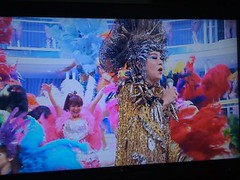鼓動 コンサート
Kodo's 2010 December Concerts Bring 2010 to a Close with 12 Shows Across 8 Cities Throughout Japan
Since their auspicious debut in 1981 at Berlin Symphonie Hall, Kodo has emerged as Japan's premiere performing arts group, setting the standard for ensemble taiko throughout the world. Touring eight months of the year both domestically and internationally, the group's annual
journey culminates every year in the annual December Concert series. The December Concerts are a chance for Kodo to regroup and review the year past, as well as to debut new material for the year to come.
This year, in addition to the regular opening night on Sado Island and performances in Niigata, Osaka, Nagoya, and Tokyo, 2010 will also see shows in Ashikaga, Sendai and Yokohama for a total of 12 shows throughout eight cities taking place December 1 through 19.
Artistic Director Mitsuru Ishizuka found his inspiration for this year's December Concerts in the Kodo Rehearsal Hall, a pivotal part of Kodo Village where the group lives and trains. The Rehearsal Hall is the bedrock of creation for Kodo performances and the starting point for the group's vigorous training program. Ishizuka designed this show to capture the atmosphere of this very special place: the enthusiasm, tension, stillness, breath, and fellowship felt between taiko and humans in this hallowed hall.
“The taiko clustered together on the stage, while based on the layout of the Rehearsal Hall, also conjures up the scene of a Japanese shrine,”explains Ishizuka.“People gather at a shrine to sing, dance, and drum so that their prayers may reach the heavens. In the same way, all of us at Kodo gather in our rehearsal hall and on stage day after day, singing, dancing, and playing the drums, in hopes that the sound of the taiko will reach as many people as possible.”
As always, the December Concert program features both classic compositions from the Kodo repertoire that have earned the group an avid following across the globe, and new compositions, such as Stride, written by Ishizuka himself and designed to make use of all of the drums in the group’s arsenal. This piece speaks of the “strides” Kodo has taken to date and the journeys that lie ahead, a perfect metaphor for the December Concerts’ year-end finale shows.
As Kodo turns the corner on three decades of history and the group prepares to enter its 30th anniversary year, the 2010 December Concerts are sure to carry a special celebratory energy and pizazz.
Ticket information and further details can be found on JapanVisitor's
What's on in Tokyo and Kyoto page.
© JapanVisitor.com
Like this blog?
Sign up for the JapanVisitor newsletterYahoo Japan Auction ServiceJapanese FriendsTokyo Apartments SearchJapan Job SearchRough Guide To JapanTagsJapanKododrumconcerttour









































